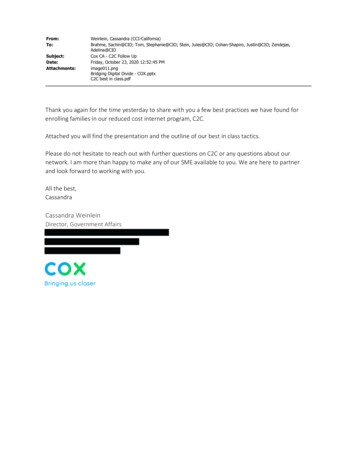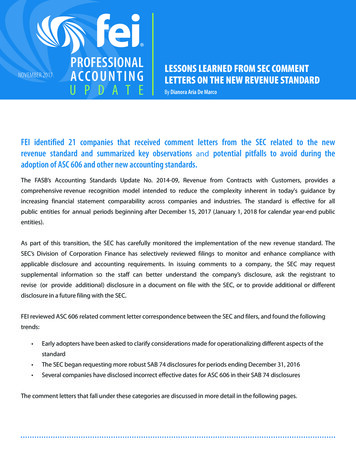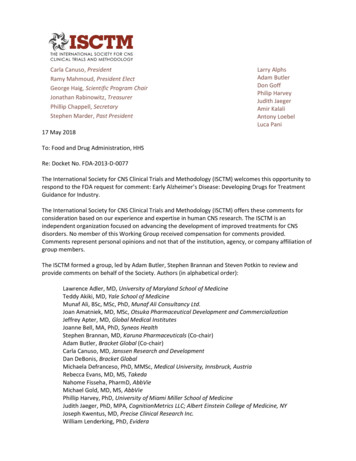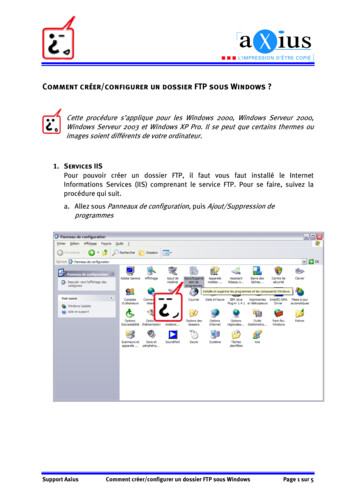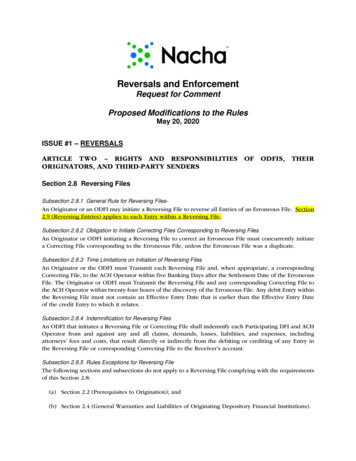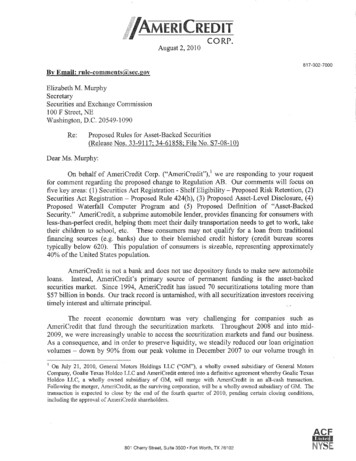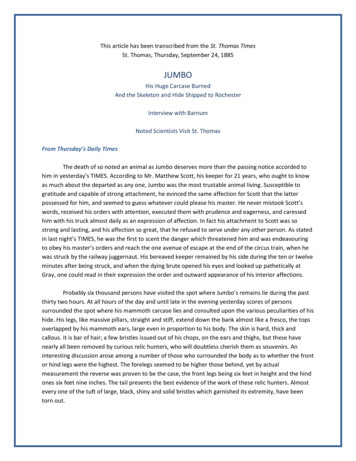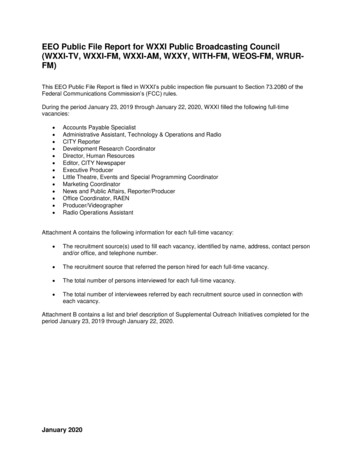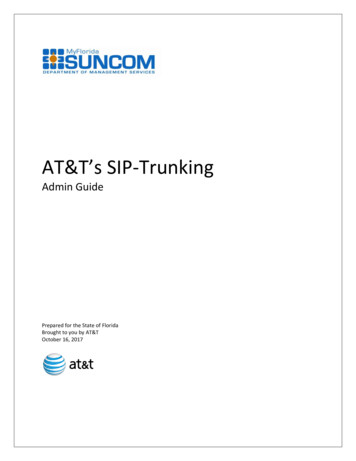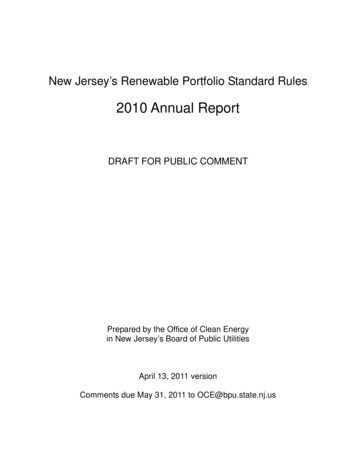
Transcription
New Jersey’s Renewable Portfolio Standard Rules2010 Annual ReportDRAFT FOR PUBLIC COMMENTPrepared by the Office of Clean Energyin New Jersey’s Board of Public UtilitiesApril 13, 2011 versionComments due May 31, 2011 to OCE@bpu.state.nj.us
1. Executive Summary2. NJ Renewable Energy Market Development Activities in 2010a. New Capacity by Technologyb. NJCEP Highlightsc. EDC SREC-based Finance Programs3. NJ RPS Reporting Year 2010 (RY10) Compliance Resultsa. Solar; requirements and resultsb. Class I; requirements and resultsc. Class II; requirements and results4. NJ Renewable Energy Market Issues and Forecast for 2011a. Regulatory Update, Administrative Issues and Legislative Changesb. EDC SREC-based Finance Program Planned Capacity for 2011c. NJ RPS Requirements; New Capacity by Source and Technology for 20115. List of Tables and Figures6. AppendicesAppendix 1. Evolution of NJ RPS RequirementsAppendix 2. List of Regulated Load Serving Entities with NJ RPS Obligations in RY10Appendix 3. NJ RPS Compliance by Reporting YearAppendix 4. NJ RPS REC Generation and Retirement in the GATS Trading PlatformAppendix 5. Class I RECs retired for NJ RPS compliance by State and Fuel TypeAppendix 6. Class II RECs retired for NJ RPS compliance by State and Fuel TypeDRAFT FOR PUBLIC COMMENT – NJ RPS 2010 Annual Report, 04/13/11, pg. 2 of 35
1. Executive SummaryThe following report provides a summary of the results from compliance with New Jersey’sRenewable Portfolio Standard (RPS) by regulated retail electricity suppliers and providersand other renewable energy market developments from 2010. The Office of CleanEnergy in the New Jersey Board of Public Utilities (the Board) oversees implementation ofthe state’s RPS rules including the facilitation of annual compliance reporting for regulatedentities. The Office of Clean Energy has issued this report toward providing policymakers, market participants and other decision makers with information to judge thestatus of the RPS rules and the affected renewable energy markets.The RPS regulations, which are authorized by the Electric Discount and EnergyCompetition Act of 1999, N.J.S.A. 48:3-49 et seq., require electric power suppliers andbasic generation service providers, referred to as “supplier/providers”, to include minimumamounts1 of renewable energy in the electricity they sell. The rules specify a separateminimum requirement for solar electric generation, for Class I renewable energy, and forClass II renewable energy. These minimum amounts increase over time to requiregreater REC retirement and demand for renewable energy. There are two methods bywhich a supplier/provider may meet the applicable minimum volumetric or percentagerequirement: by retiring renewable energy certificates (RECs), each representing therenewable energy attributes of a megawatt hour (MWh) of electricity; or by submittingalternative compliance payments (ACPs).The RPS requires supplier/providers to submit compliance reports by October 1, fourmonths after the close of each “Reporting Year2” (RY) (N.J.A.C. 14:8-2.11). Thecompliance results summarized in this report cover RPS Reporting Year 2010 (RY10),which ended May 31, 2010. During RY10, over 77 million MWh of retail electricity weresold by supplier/providers, down significantly from RY09’s 81 million MWh. Retail sales inNew Jersey’s regulated electricity markets were the lowest since the RY05 complianceyear level. Lower retail sales were attributed to mild weather and the economic recession.For Class I and Class II renewable energy, the RY10 minimum percentage requirements,4.685% and 2.5% respectively, were met almost entirely through the retirement ofRenewable Energy Certificates (RECs). This is the second consecutive year, since RECswere authorized by the Board for use in NJ RPS compliance, that the Class I and Class IIrequirements were achieved largely through REC retirement, with little or no use of ACPs.Over three million (3,627,069) NJ Class I RECs and less than two million (1,935,469) NJClass II RECs were retired toward RY10 compliance. Class I REC prices were reportedat all time low of 2.00 per REC by the end of RY10. Eligible new capacity appears to becoming online at a faster pace than the aggregated demand from regional state RPSs.1The Solar Advancement Act of 2010 signed January 17, 2010 directed the Board to change the NJ RPS solarrequirements from a percentage basis to a volumetric requirement effective upon adoption. The Board proposedamendments to the RPS regulations on March 30, 2011. The EY11 solar requirements are 306 GWhs.2The Solar Advancement Act of 2010 also changed the terminology for a compliance period for the NJ RPS from a“Reporting Year” to an “Energy Year”. This amendment and other regulatory changes proposed on March 30, 2011will be published in the New Jersey Register with a 60 day public comment period.DRAFT FOR PUBLIC COMMENT – NJ RPS 2010 Annual Report, 04/13/11, pg. 3 of 35
By contrast with the Class I and II compliance results, there were insufficient SRECs tomeet the RY10 minimum percentage requirement for solar electric generation, whichincreased from 0.16% in RY09 to 0.2210% in RY10. The RPS required 171,095 SRECsor SACP payments and regulated entities retired only 123,717 SRECs for RY10compliance. Over 72% of the NJ RPS solar requirements in RY10 were met with SRECsretired compared with less than 58% of the solar obligation in the previous complianceyear (RY09) fulfilled with SRECs. As a result of the relatively higher levels of compliancevia SREC retirement, the cost of SACP payments fell from RY09’s 38.9 million to 32.8million in RY10. On March 30, 2011, the Board approved an RPS rule amendment whichproposes a process for returning these funds to ratepayers as required by the SolarAdvancement Act of 2010.The Office of Clean Energy estimates the total cost of compliance with the RY10 RPS wasapproximately 122 million, slightly more than RY09’s cost of RPS compliance calculatedat 120 million. The solar RPS requirement is estimated to have cost approximately 109million: 32.8 million paid in SACPs plus more than 76 million in SRECs purchased forretirement. The Class I requirements are estimated to have cost approximately 11million and the Class II requirements cost less than 2 million. Supplier/providers, whobear the obligation of RPS compliance, are presumed to pass through to their customers,the New Jersey electricity ratepayers, the majority of these costs. In addition, over 47million in solar rebate payments were made on CORE and REIP commitments in 2010.The SREC-based finance programs administered by the Electric Distribution Companies(EDCs) achieved several significant milestones in 2010. The first projects awarded longterm SREC contracts in the program offered to JCPL, ACE and Rockland customers wereconstructed and began contributing SRECs. And PSEG’s Solar Loan and Solar For AllPrograms each contributed significant amounts of new capacity to NJ’s SREC market.The first auction of SRECs created by participating projects occurred in January 2010,with additional auctions held in July and October. All SRECs auctioned had originated inthe PSEG solar programs and will be used to offset the 217 million in solar investmentsreported as incurred in 2010.The market for renewable energy, particularly solar photovoltaic installations, in NewJersey during 2010 was strong despite the national economy’s slow emergence from therecession. Solar installations in New Jersey continued to come online at anunprecedented rate through both the Board’s New Jersey Clean Energy Program(NJCEP) rebate programs and the non-rebated SREC Registration Program (SRP). Solarproject installation reached an all-time monthly high in December 2010 with 24 MWs ofcapacity reported through the rebate and SREC Registration programs.New Jersey’s renewable energy market, as a result of our RPS program, continues toattract diverse participants including facility owners of all sizes, renewable energygeneration project developers, system installers, energy brokers, aggregators and auctionhosts. However, since our state’s RPS comprises one portion of the regional compliancemarket for RECs and is complemented by other states’ markets, continued review of ourgoals and objectives in light of regional developments is warranted.DRAFT FOR PUBLIC COMMENT – NJ RPS 2010 Annual Report, 04/13/11, pg. 4 of 35
2. NJ Renewable Energy Market Development Activities in 2010The 2009 Annual Report for New Jersey’s Renewable Portfolio Standard Rules (2009Report) issued February 8th, 2010 includes a comprehensive chronology of the evolutionof the state’s RPS rules and the basic elements driving NJ renewable energy marketdevelopment. Readers unfamiliar with the significant changes in state renewable energyincentive policy are encouraged to review the 2009 Report which can be accessed -council-committees/rps-rule-revisions.New Jersey renewable energy market development activity is reported via a variety of“project activity reports” issued periodically through the Renewable Energy Committee listserver and posted on the NJCEP website at ct-activity-reports/project-activity-reports. The sources of new capacityeligible to create RECs for use in New Jersey’s RPS are different for each category; solar,Class I and Class II. The sources of new installations eligible to create SRECs for use inthe NJ RPS include the legacy solar rebate programs; CORE and REIP, as well as theSREC Registration Program. The SREC Registration Program was established in 2007 toenable projects to participate in the NJ SREC market without first receiving an NJCEPrebate. The Board authorized its contractors, known as the Renewable Energy MarketManagers, to issue the last rebate commitments in the CORE program in 2009.On December 6, 2010, the Board approved the Market Manager’s request to issue thelast remaining solar rebate commitments in the REIP for applications received inSeptember 2010. The Board also approved a new EDC Solar Finance Incentive (EFSI)program with a budget of 3.8 million for small solar projects; residential less than 10 kWand commercial less than 50 kW. To participate in the EFSI program, projects must belocated in JCPL, ACE or Rockland territories, register in the SREC Registration Program,receive an award in the competitive SREC solicitation process, install and fulfill finalprogram inspection processes by December 31, 2011. The intent of the EFSI is tomotivate developer participation in the under-subscribed, small solar market segment ofthe EDC SREC-based finance programs. The PSEG solar finance programs were notdeemed to be under-subscribed hence their participants are ineligible in the EFSIincentive program.a. New Capacity by TechnologyIn the NJ RPS, Class I and Class II RECs can be created by facilities generating energy“within or delivered into the PJM region, as defined in N.J.A.C. 14:4-1.2. Energygenerated outside the PJM region shall be considered delivered into the PJM region if ithas been added to the PJM region through dynamic scheduling of the output to loadinside the PJM region” (N.J.A.C. 14:8-2.7 (b)). Facilities eligible to create Class I andClass II RECs have included those that participate in the NJCEP rebate and grantprograms as well those from 9 other states (Appendix 4).The Office of Clean Energy certifies renewable energy facilities that seek to create RECsthrough the PJM-EIS Generation Attribute Tracking System (GATS) for use in the NJDRAFT FOR PUBLIC COMMENT – NJ RPS 2010 Annual Report, 04/13/11, pg. 5 of 35
RPS. In RY10, no new facilities were certified as eligible to create Class II RECs, but 29new facilities from seven states for nearly 1200 MW of capacity was certified as eligible tocreate NJ Class I RECs within PJM-EIS GATS (Table 1). The newly certified facilitiesinclude six wind and one biomass project provided NJCEP rebates in calendar year 2009.Table 1. New Capacity Certified as NJ RPS-eligible Class I by State in RY10NJ Class I Certified Capacity Added inGATS for RY10 50349.659.2162.20100.516.316.331.976 1191.7306As of December 31, 2010, nearly 300 MW of solar and NJ Class I renewable energycapacity had been installed in New Jersey as a result of the incentives available throughthe NJCEP, the net metering and interconnection regulations and the Renewable PortfolioStandard regulations. The solar photovoltaic market has provided the greatest portion ofthe state’s renewable energy capacity (259 MWdc) and by an equally large margin thegreatest number of installations at over 8,000 systems. Biomass installations are thesecond largest resource by aggregate capacity participating in the NJCEP with nearly 31MW installed followed by wind installations with nearly 7.9 MW (Table 2).Table 2. Installed Projects Participating in the NJCEP from Inception through 2010NJCEP Renewable Energy TechnologiesInstalled Projects 2001 to 12/31/2010TechnologySolar# ProjectsTotal kWTotal Rebate 8,037259,674.3 349,578,777Biomass1730,905.0 14,188,624Fuel Cell81,505.0 4,707,312337,899.1 4,717,5228,095299,983.3 373,192,234WindTotal*DRAFT FOR PUBLIC COMMENT – NJ RPS 2010 Annual Report, 04/13/11, pg. 6 of 35
The majority of the solar energy capacity eligible to participate in the RPS was installed inthe last year with more than 132 MWdc of solar photovoltaics connected to the electricdistribution system serving New Jersey in 2010 (Figure 1 and Table 3). In fact, theamount of solar capacity installed in 2010 exceeded the cumulative capacity installedsince the inception of the clean energy incentive programs in 2001.Figure 1. NJ RPS-eligible Solar PV Capacity Installed by Year and CumulativeInstalled Capacity (MW dc)NJ Solar Installed Capacity by Year3002502001501005002001200220032004Capacity Added200520062007200820092010Total Installed CapacityTable 3. NJ RPS-eligible Solar PV Installations; Number, Capacity and Rebates AnnuallyNew Jersey Solar Installations by Year As of 12/31/10Projects 10 kWYear#ProjectsTotal kWProjects 10 kWTotal Rebate #Projects200137.51 37,145.00020023097.89 481,790.077Total kWAll Projects#ProjectsTotal Rebate - Total kWTotal Rebate -37.5525.56 1,942,904.0037623.5 2,424,694.0737,145.00 5,323,410.81200388464.34 2,487,130.817712.30 2,836,280.00951,176.620042691,561.95 8,445,045.8020475.18 2,136,928.902892,037.1 10,581,974.7020055934,007.09 21,631,077.381365,900.96 24,604,819.387299,908.1 46,235,896.7620067174,697.60 24,259,420.1315013,622.78 53,827,366.2186718,320.4 78,086,786.3420075864,146.97 19,388,536.3210711,111.30 38,733,849.7069315,258.3 58,122,386.0220086454,422.84 18,172,868.3219018,297.64 26,788,695.0683522,720.5 44,961,563.3820099776,941.50 17,648,890.3437350,313.23 39,031,140.90135057,254.7 56,680,031.242010223315,531.75 20,316,104.12906116,835.89 26,808,784.203139132,367.6 47,124,888.32Total6,14141,879.4 132,868,0081,896217,794.8 216,710,7688,037259,674.3 349,578,777Total* Program to date totals for Paid projects plus projects pending payment; preliminary results subject to true-up based upon inspection results.Also noteworthy in 2010, the amount of solar capacity originating from the SRECRegistration Program and its predecessor, the SREC-only Pilot Program at 145 MWdc,surpassed the amount of capacity of projects that have participated in the NJCEP rebateprograms; CORE and REIP combined at 114 MWdc. (Table 4)DRAFT FOR PUBLIC COMMENT – NJ RPS 2010 Annual Report, 04/13/11, pg. 7 of 35
Table 4. NJ RPS-eligible Solar by Source Installed through 2010New Jersey Solar Installations by Program, as of 12/31/10Program#ProjectsInstalled Capacity(KW dc)CORE Solar4,26386,132.0REIP Solar2,70127,775.9 SREC Reg. Pgm. Total*1,0738,037145,766.4% of InstalledCapacityTotal Rebate 311,562,408.7233.2%38,016,367.9210.7%-56.1% 259,674.3 349,578,777100%Total* Program to date totals for paid projects plus projects pending payment; preliminary resultssubject to true-up based upon inspection results.SREC Reg. Pgm. SREC Registration Program participants as well as its predecessor SREC-OnlyPilot Program.b. NJCEP Highlights for 2010The SREC Registration Program (SRP) was the largest source of newly installed capacityeligible to meet the solar requirements in the New Jersey RPS in 2010. With over 100MW installed in the past year, non-rebated solar projects supplied over 77% of the newcapacity to produce SRECs (Table 5). The relative growth in new supply from the nonrebated programs are the expected result of the decision by the Board in 2007 to reducethe importance of administratively-determined rebates in the transition to a greaterreliance on providing incentives through the market-based SREC market. As the NJCEPrebate programs cease making new commitments for solar energy projects, the pipeline ofproposed solar capacity continues to become dominated by SRP projects.Table 5. NJ RPS-eligible Solar by Source Installed in 2010New Jersey Solar Installed by Program in 2010ProgramSourceCORE SolarREIP SolarSREC SolarTotal# ProjectsSystem SizeRebate Amount1752,0559093,1398,22922,118102,020132,368 17,951,325 29,173,563 0 47,124,888DRAFT FOR PUBLIC COMMENT – NJ RPS 2010 Annual Report, 04/13/11, pg. 8 of 35% of TotalkW6.2%16.7%77.1%100.0%
The NJCEP wind rebate program had six new small wind installations complete in 2010for 100 kW of aggregate capacity and nearly 300,000 in rebate payments. These sixnew projects join twenty five other projects less than 50 kW bringing the total capacity ofsmall wind installations to 399 kW (Table 6).Table 6. NJCEP Rebated Wind Installations by Year through 2010NJCEP Rebate Program Wind Installations by YearAs of 12/31/10Projects 50 01.021.8245.9100.0399.1sAll ProjectsTotal RebateAnnual Cumulative#Projects kWkWTotal Rebate 432 63,453 50,000 5,000 92,406 687,050 299,939 1,198,28100.010.4220.000.0110.01 2,625.011.0321.817245.96100.032 4.13,024.1 ,017,522The Jersey Atlantic Wind (JAW) facility installed at Atlantic County Utility Authority in 2005remains the largest project provided a rebate with 2.625 MW of capacity providingelectricity onsite. The balance of the JAW facility at 4.875 MW was furnished with aNJCEP grid supply grant. The six new wind projects installed in 2010 brings the state’stotal wind capacity installed with grants and rebates to nearly 8 MW.Figure 2. Wind Capacity Provided Rebate in the NJCEP by Year and CumulativeN JC E P R e bate P rogram Wind Installations by Y e ar3,500.03,000.0KW 20042005200620072008A nnual kW20092010Cumulativ e kWDRAFT FOR PUBLIC COMMENT – NJ RPS 2010 Annual Report, 04/13/11, pg. 9 of 35
The NJCEP biopower rebate program had one project complete in 2010 for 280 kW ofcapacity with 490,000 provided in rebates. This new project brings the state’s total forrebated biopower capacity to nearly 8.3 MW through approximately 6.6 million in rebates(Table 7). Adding the newly rebated project to the total for all NJCEP biopower projectsreceiving rebates and grants brings the cumulative capacity to nearly 31 MW through2010.Table 7. NJCEP Rebated Biopower Installations by Year through 2010NJCEP Rebate Program Biopower Installations by YearAs of 12/31/10Year# ProjectsCumulativekWAnnual kWTotal Rebate 2001--- -20021150150 560,00020032150300 153,5942004--300 -200521,8502,150 2,390,0002006--2,150 -200721,1503,300 1,170,000200821,1854,485 732,000200923,4907,975 1,079,805201012808,255 490,000Total128,255 6,575,399c. EDC SREC-based Finance ProgramsA key element in the Board’s 2007 cons
And PSEG’s Solar Loan and Solar For All Programs each contributed significant amounts of new capacity to NJ’s SREC market. The first auction of SRECs created by participating projects occurred in January 2010, with additional auctions held i
